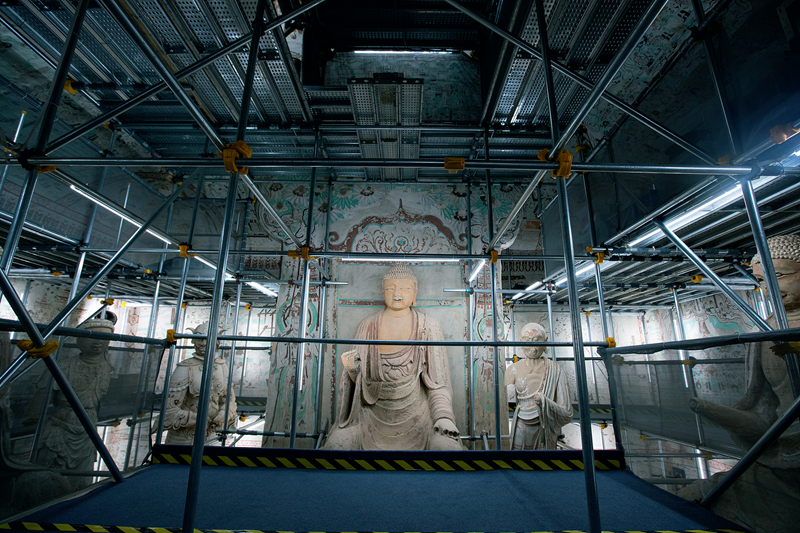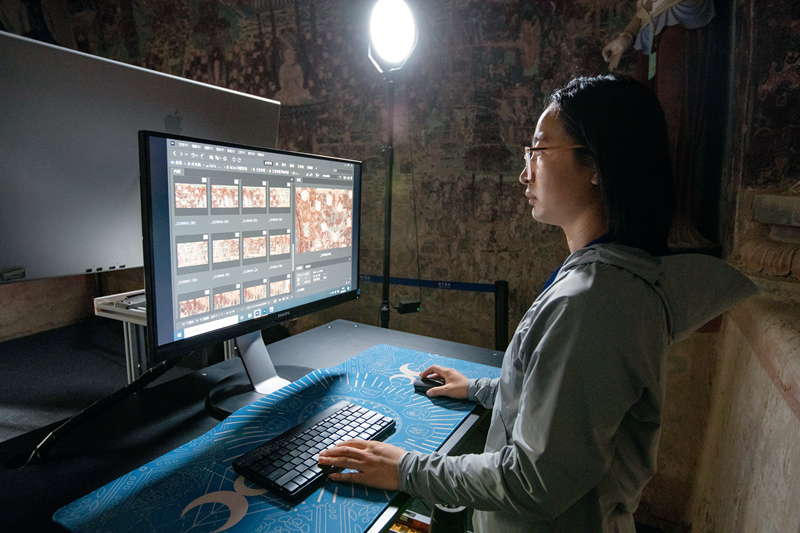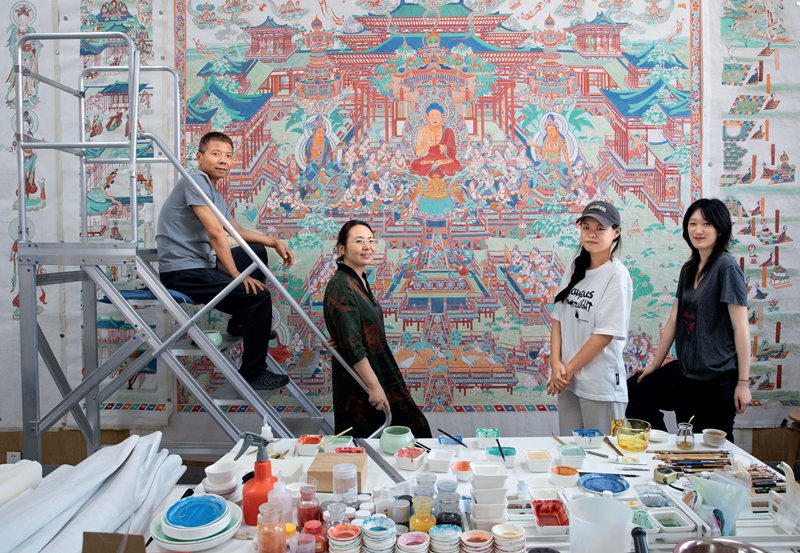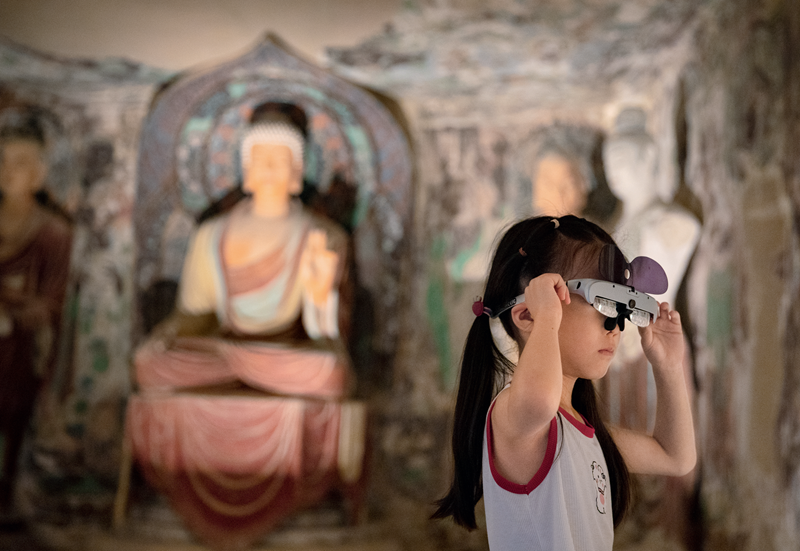Eternal Dunhuang Culture

When the first grotto was dug out in 366, the Dunhuang area was blanketed with green forests and fields. In the Tang Dynasty (618-907), the desertification process intensified in the area, leaving Dunhuang covered with dried riverbeds and endless stretches of shifting sands. For hundreds of years since the mid-16th century, the unattended Mogao Grottoes suffered from natural disasters and man-made damage. In 1944, the National Dunhuang Art Research Institute, the predecessor of the Dunhuang Academy, was established to conduct the protection and restoration of the Mogao Grottoes alongside the study of Dunhuang culture.
Restoring the Old
The murals are one of the primary targets of cultural relics protection in Dunhuang. The walls were continuously painted from the Sixteen Kingdoms period (304-439) to the Yuan Dynasty (1271-1368) and are now facing various maladies after centuries of weathering.
A large one among the Mogao Grottoes in Dunhuang, Cave 55 was constructed around the year 962 during the Northern Song Dynasty (960-1127). According to Yin Zhihong, a mural restoration expert from the Dunhuang Academy, since protection work first began on this cave’s murals in 2022, everything has strictly adhered to several procedures: First, a comprehensive assessment of its historical, artistic, and scientific value is conducted, followed by a thorough investigation and documentation of the current state of the murals and monitoring of the environment. Then, a scientific analysis of the materials used in the murals and the mechanisms for their deterioration is performed. Conclusions from the analysis guide the selection of materials and techniques for restoration, and a plan for conservation and restoration is then developed and implemented. Yin stressed the importance of this set of procedures for cultural relics preservation.

Yu Yin from the Institute for the Digitization of Cultural Heritage at the Dunhuang Academy checks the technical parameters of captured images on a computer. (Photo by Dong Fang/China Pictorial)
“The Mogao Grottoes currently hold 45,000 square meters of murals,” said Yin. “Modern cultural relic conservation adheres to the principle of minimal intervention. The materials and techniques used in the conservation and restoration of Cave 55 are all reversible, aiming to restore the old to its previous state while avoiding ‘protective’ damage. If the best technology available doesn’t fit, we’d rather keep it as it is to leave space for future restoration.”
“Many problems have already been fixed, and the current problem being treated is peeling,” said Yin. Peeling is a common problem for murals, when the base color layer or pigment layer of murals begins cracking, curls up, and even falls off. Even the most skilled professionals can only repair an area the size of a palm in a day. According to Yin, restoration of the 500 square meters of murals in Cave 55 might take a team of seven or eight professionals four to five years.
“The cultural relics we have repaired can be preserved for at least another 10 years, or even several decades,” he said. “We want to make sure future generations can still appreciate their beauty.” The Dunhuang Academy boasts over 100 mural painters and repairers like Yin Zhihong. For the past 80 years, the institution has developed a complete set of mural conservation techniques and scientific processes, allowing Dunhuang culture to thrive continuously.

The restoration and replication project team assigned to Cave 172 of the Mogao Grottoes in front of the soon-to-be-completed mural The Contemplation Sutra, August 1, 2024. (Photo by Dong Fang/China Pictorial)
New Digital Life
Achieving permanent preservation and sustainable use of cultural relics has always been an elusive goal for conservation experts. In the late 1980s, Fan Jinshi, then executive deputy director of the Dunhuang Academy, first proposed the concept of “Digital Dunhuang.” In April 2006, the Dunhuang Academy finally established a digital center, which was later renamed the Institute for the Digitization of Cultural Heritage. The institute primarily applies digital technology to efforts related to the Mogao Grottoes and relevant cultural relics, giving new life to Dunhuang cultural heritage in the digital world.
The Dunhuang Academy has now developed a complete set of key technologies and working standards for digitizing murals. “This high-fidelity automatic mural photography equipment is guided by software to take segmented shots according to set parameters and sequencing to capture all information of the images on the walls.”
In Cave 341 of the Mogao Grottoes, Yu Yin, a staff member with the Institute for the Digitization of Cultural Heritage, was checking images transmitted in real time. “By enlarging a picture, you can clearly see every detail,” he said. “For instance, you might notice when a painter drew the fingers of a figure too thick or the toes were off. It’s amazing.”
After data collection, manual piecing of photos is performed. Because each person can only piece together about 20 photos a day, completing the entire mural on each wall will take about two months. The puzzle must be pieced together perfectly; even the hair of figures must achieve “seamless connection.” Three-dimensional reconstruction of painted sculptures requires massive amounts of data. Just for the main Buddha statue in Cave 45 of the Mogao Grottoes, which is over one meter high, digital reconstruction used more than four million triangular meshes. The body length of the Nirvana statue in Cave 158 is 15.6 meters, and three-dimensional reconstruction of this cave took two years, with triangular meshes numbering over 100 million.
At the Institute of Fine Arts under the Dunhuang Academy, artists have been recreating the grand Tang Dynasty ambiance of Cave 172 of the Mogao Grottoes. This cave was built during the heydays of the Tang Dynasty. Each of the northern and southern walls features a giant mural, representative works of the mural art of the prosperous Tang Empire. However, many of the murals are now discolored and blurred, and some parts are even missing. In 2016, a dozen artists from the Institute of Fine Arts started working together to restore and replicate the murals of the entire cave. It is the first complete-cave mural replication project by the Dunhuang Academy.
Copying is a key measure for preventive conservation of the murals in the Mogao Grottoes. “The hardest part in restoring and replicating Cave 172 is that some of the mural colors have turned black,” said Han Weimeng, deputy director of the Institute of Fine Arts, who is overseeing the project. “Restoration and copying involve research and a process of conversing with the ancient people. Based on the accurate forms of figures, we are decoding the colors and reading historical documents to ensure the essence, energy, and spirit of the original murals are eventually presented in the copied works.”
Today, “Digital Dunhuang” has become an important window and brand for promoting Dunhuang culture to the world. On August 27, 2024, the Dunhuang studies research library, an online database gathering the research achievements and first-hand materials on Dunhuang studies from around the world, was officially launched, providing an open and shared academic resource platform for scholars globally.
Dunhuang culture originates from China, but Dunhuang studies belong to the world.

A visitor wears AR glasses at an immersive tour of a replica cave of the Dunhuang grottoes, August 1, 2024. (Photo by Dong Fang/China Pictorial)